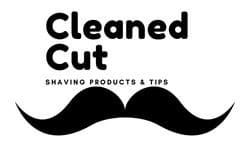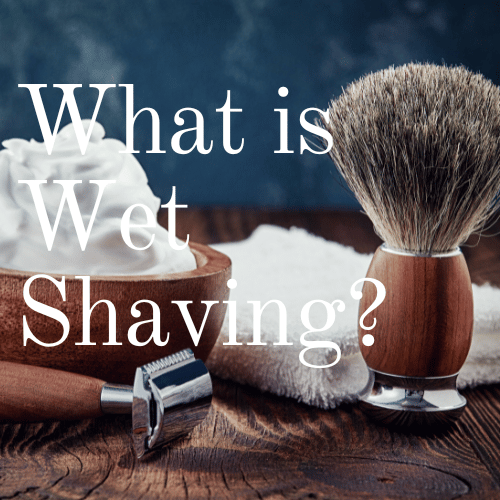Wet shaving is the method of shaving that most people learn first. The process involves keeping the skin wet and moisturized during the shaving process. Typically, a blade or razor is used when wet shaving, while there are also electric razors that can be used “wet” as well.
Depending on your preference and how often you shave, you may opt for a mixture of wet and dry shaving routines. Dry shaving with an electric shaver may be convenient and less of a hassle, but wet shaving offers many benefits to the health and appearance of your skin.
Benefits of Wet Shaving
Wet shaving has many benefits when done correctly. I have met multiple people who would beg to differ, but that’s because they haven’t perfected the technique. Shaving with a blade, especially a double-edged safety razor or straight edge blade, can improve your skin’s overall appearance and health with the proper technique. Note: wet shaving with a safety razor or straight edge razor is a skill that involves a bit of practice, but yields the best results.
At a glance, wet shaving offers benefits such as:
- Closer shave
- Less ingrown hair
- Cleaner better looking skin
- Less irritation
- Longer lasting
- Far less expensive over time (when using a safety or straight razor)
Wet Shaving Vs Dry Shaving
Wet shaving is and will always be superior to dry shaving due to the many benefits mentioned in the previous section. Dry shaving, while super convenient, can lead to more irritation, rashes, infections, and even ingrown hair. I only opt to dry shaving when there simply isn’t enough time to do a full-on wet shave.
For those who absolutely prefer to dry shave with an electric shaver, cleansing your skin and lubricating it is important. As mentioned in my review of the Andis foil shaver, irritation from an electric shaver can be almost completely avoided by prepping. Cleaning your face thoroughly and applying pre-shave oil can set you up for a great electric shave.
Types of Wet Shaving Razors
Wet shaving is typically done with a manual razor, but exceptions exist. Below is a list of the types of wet shaving razors:
- Single or double-edged safety razor (by far my favorite)
- Straight or cut-throat razor
- Disposable cartridge razor
- Completely disposable razor
- Wet shave-capable electric razors
Wet Shaving Cream Vs Soap
Deciding between shaving cream or soap is primarily a preference thing. The difference between shaving soap and shaving cream is mainly in the consistency of the lather. Shaving soaps generally have a lighter thickness and are removed from the face more with each pass of your blade. Creams, on the other hand, are far thicker.
Shaving creams already contain a bit of water, so there is less prep when compared to shaving soap. Shaving soap usually comes in puck form and must be lathered by wetting a brush and swirling it on the puck in a bowl or cup.
Speaking of preference, I always go for shaving soap over shaving cream. I find that the consistency of shaving soap along with how it comes off the skin performs far better with my safety razor setup. Shaving soaps also last WAY longer than a tin of shaving cream, which saves even more money when combined with a safety razor wet shaving setup.
Building Your Wet Shaving Kit
If you’re looking to get started with traditional wet shaving, you might be wondering what you’ll need. If you opt for a simple setup such as a disposable razor and canned cream, all you need is the two and perhaps an aftershave. If you are opting for a safety razor or straight edge razor setup, you’ll want to grab the following:
- Shaving cup or bowl: A shaving cup or bowl allows you to lather your cream or soap. With a soap, you simply leave the puck in the cup and add water/ swirl your brush. With a cream, swipe some cream onto your brush and swirl in your bowl, adding water as needed. You could buy a shaving scuttle or shaving bowl depending on whether you are using a cream or soap. I own multiple, but ultimately ended up using an oversized coffee mug with a giant K on it I got in a gift basket for Christmas one year :-D.
- A quality shaving brush: Shaving brushes come in all shapes and sizes. Opt for a brush made of quality material such as badger bristles. I use and recommend a Parker shaving brush.
- Your preferred razor: Safety razors and straight-edged razors are both skills that require technique. While I prefer a safety razor for speed and ease of use, you might prefer the alternative. Experimenting here is the key to deciding. Out of over a dozen safety razors, I use and recommend MANSCAPED The Plow 2.0.
- A blade bank: Blade banks allow you to store and dispose of your old blades safely. Simply deposit a blade into the bank once finished shaving. When the bank is full, dispose of the entire thing. These are especially important if you have children in the household. All blade banks are simple and are designed the same way, such as this blade bank.
- A quality pre-shave oil: Pre-shave oil drastically reduces friction while shaving with a razor and I cannot recommend it enough. I use and recommend Viking Revolution pre-shave oil.
- Aftershave: Aftershaves come in balms, lotions, or splashes. I use and recommend Proraso aftershave.
Takeaway
Wet shaving is the superior method of shaving to avoid irritation, infection, ingrown hairs, and other common problems. A good wet shaving routine can not only give you a great shave but also improve the health of your skin. There are numerous different razors available to use including safety razors (my favorite), straight-edge razors, disposables, and even some electric options (although they don’t perform as well). Deciding on a shaving cream vs a shaving soap comes down to your setup and preferences.



